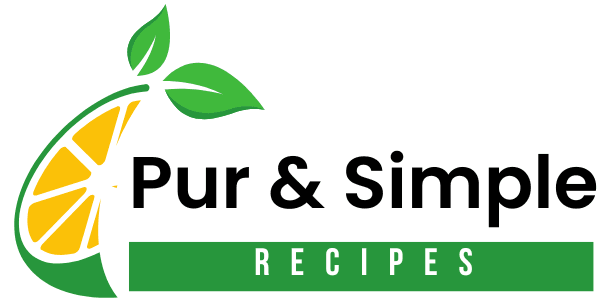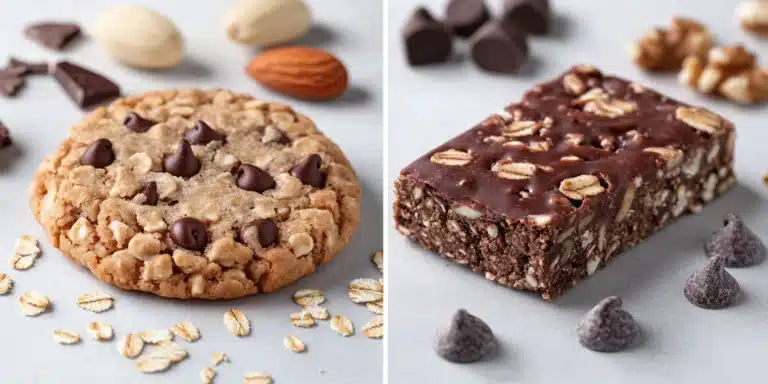Alright, fitness enthusiasts and health-conscious folks, let’s explore a common debate: the protein cookie versus protein bars! 🍪💪 Like many, you’re likely juggling a busy lifestyle with the desire to make smart food choices. This often leads to protein-packed snacks, such as the protein cookie and protein bars. With so many options, it’s easy to be confused about which is better. Are protein cookies just a disguised treat, or a viable protein source? Are protein bars always healthier, or are they full of hidden sugars? In this article, we’ll break down these popular snacks, compare their nutritional value, explore their pros and cons, and help you decide which is best for you. So, let’s get started! 🚀
Understanding the Basics: Protein Cookies and Protein Bars
Before we compare them nutritionally, let’s understand what protein cookies and protein bars are. Knowing the basics is important for making informed food decisions. It’s more than just choosing between a cookie and a bar. Let’s look at the details.
What are Protein Cookies?
Protein Cookie are designed to resemble traditional cookies, but with added protein. They include protein sources like whey, casein, or plant-based powders. Often marketed as healthier alternatives to regular cookies, they satisfy your sweet cravings while boosting protein intake. They come in various flavors and textures, mimicking a “real” cookie with added benefits. Some are soft, others crunchy. The goal of a **protein cookie** is to offer a healthier treat. It is like having your cake and eating it too! 😉
What are Protein Bars?
Protein bars are designed as compact, convenient protein sources for on-the-go consumption. They are denser than **protein cookies** and are made from protein, carbs, and fats bound together. They come in a variety of flavors and textures. Protein bars serve as meal replacements, post-workout snacks, or a way to increase protein. They offer a balanced mix of nutrients for busy days. They’re popular because they’re portable and easy to eat. 💪
Common Goals: Why People Use Protein Snacks, Including the Protein Cookie
Why do people choose **protein cookies** and protein bars? It’s not just about a quick snack, but often for a specific purpose. Let’s look at some common reasons. A main reason is to increase protein intake. Protein is key for muscle building and overall function. Protein snacks offer a convenient way to meet daily needs, especially for active people. Also, protein snacks are popular for those managing their weight. Protein keeps you full, which can reduce calorie intake. Furthermore, they prevent muscle loss during weight loss. For others, it’s about convenience. They’re easy to grab and are ideal for busy times. Finally, many want a healthier sweet treat. Protein snacks can satisfy cravings without derailing healthy habits. It’s about having tasty, convenient options aligned with health goals. ✨
Nutritional Showdown: A Detailed Comparison of the Protein Cookie and Protein Bars
Now we know what **protein cookies** and bars are, let’s look at the nutrition. It’s more than just protein content. Let’s compare these popular snacks based on key nutrients.
Protein Content: How Much Are You Actually Getting from a Protein Cookie or Bar?
The main goal of **protein cookies** and protein bars is to provide protein. But how much are you actually getting? Protein content varies greatly depending on the brand, ingredients, and formula. Protein bars often have more protein per serving than **protein cookies**. Some bars have over 20 grams of protein, while **protein cookies** range from 5-15 grams. Always check the nutrition label for the protein content per serving, and the source of protein. High-quality protein, like whey or casein, is best. Knowing the amount and source of protein is key to making a smart choice.
Carbohydrate Breakdown: Simple vs. Complex Carbs in Protein Snacks
When checking carbohydrate content, consider the type of carbs. Simple carbs, like sugar, digest quickly, causing blood sugar spikes and crashes. Complex carbs, like whole grains and fiber, digest slowly, providing sustained energy. Protein bars often have a mix of simple and complex carbs. **Protein cookies** may lean more toward simple carbs, especially if they are designed to be a treat. If you want sustained energy, choose protein snacks with more complex carbs. If you need a quick boost before a workout, choose one with more simple sugars. The type of carbohydrate really matters!
Fat Content: The Good, The Bad, and The Necessary in a Protein Cookie and Protein Bar
Fat content in protein cookies and bars is also important. Not all fats are created equal. Healthy fats, like monounsaturated and polyunsaturated fats, are key for bodily functions. They are found in nuts, seeds, and avocados. Saturated and trans fats are less desirable and can be harmful in excess. Saturated fats are in animal products and processed foods. Trans fats are found in processed foods and are best avoided. Protein bars often have more fat than **protein cookies**, and the type of fat varies. Choose protein snacks that have a good balance of healthy fats, while keeping saturated and trans fats minimal. It’s important to know what you are putting into your body.
Fiber: The Often-Overlooked Nutrient in a Protein Cookie and Protein Bar
Fiber is an important, but often overlooked, nutrient in protein snacks. It helps with digestion, promotes fullness, and regulates blood sugar. Many protein bars are fortified with fiber, while protein cookies generally have less fiber. Fiber is usually found in whole grains, fruits, and vegetables. Protein bars often have more fiber, because they are designed to be a meal replacement. There is soluble and insoluble fiber, both important for health. If you want more fiber, protein bars might be a better choice than protein cookies.
Sugar Levels: Hidden Sugars and Artificial Sweeteners in Protein Snacks
Let’s talk about sugar! Sugar is a big concern with protein snacks. Many protein cookies and protein bars are full of hidden sugars. Read labels carefully and look for words like sucrose, glucose, fructose, and corn syrup, as these are all different names for sugar. A long list of ingredients means there are likely added sugars. To make up for the lack of sugar in some products, some manufacturers will use artificial sweeteners, such as sucralose, aspartame, and stevia. Although they don’t add calories, there are concerns about their health impacts. If you prefer to avoid these, choose options with fewer artificial sweeteners. Choose protein snacks with lower sugar levels and fewer artificial sweeteners to stay on track with your health goals.

Texture, Taste, and Satisfaction: The Sensory Experience of a Protein Cookie and Protein Bar
Let’s move beyond the nutrition facts and discuss the sensory experience of eating a protein cookie or a protein bar. The taste, feel, and satisfaction are as important as the nutritional content. It’s about enjoying your food and making choices that make you feel happy.
The Cookie Advantage: Taste and Enjoyment with a Protein Cookie
Protein cookies try to replicate the taste and feel of traditional cookies, and appeal to those wanting a sweet treat. There’s comfort in eating a cookie, and protein cookies try to capture that feeling. They offer soft, chewy, or crunchy textures and come in various flavors. If you love cookies but want a healthier alternative, **protein cookies** can be great. The taste and enjoyment make it a satisfying snack.
The Bar Advantage: Convenience and Portability of a Protein Bar
Protein bars excel in convenience and portability. They’re quick and easy snacks that you can eat on the go, whether you’re going to the gym, office, or running errands. Protein bars are usually individually wrapped, making them easy to carry. They also require no preparation, so you can eat them instantly. They are ideal for busy times when you have no time for a full meal. The convenience of protein bars makes them a good choice for those with a busy schedule. It is easy to grab one and keep going! 🏃♀️
The Satisfaction Factor: Feeling Full and Content After a Protein Snack
Beyond taste and texture, consider how satisfied you feel after eating a **protein cookie** or bar. Do they keep you full? Or do they leave you wanting more? Satisfaction is affected by the protein and fiber content, and the snack’s overall nutrition. Protein bars are often designed as meal replacements, so they tend to be more filling. However, they may have less satisfying textures than **protein cookies**. On the other hand, **protein cookies** are focused on taste and texture, so they might not be as filling as protein bars. The feeling of satisfaction is personal, so experiment to see which snack keeps you full and happy.
Ingredients Matter: Decoding Labels and Making Smart Choices When Buying a Protein Cookie or Bar
Let’s talk about ingredients. The quality of a **protein cookie** or protein bar depends on its ingredients. It is important to check the ingredient list carefully. Let’s look at some ingredients that are good, and some that are not.
The Good Ingredients to Look For in Your Protein Cookie or Bar
When reading labels, look for ingredients that provide nutritional value. Choose high-quality protein sources like whey, casein, soy, pea, or brown rice protein. Opt for complex carbohydrates like whole grains, oats, and brown rice flour. Choose healthy fats from nuts, seeds, avocados, or coconut oil. Look for ingredients that provide fiber, such as flax seeds, chia seeds, and oats. Natural sweeteners, like honey, maple syrup, and dates are good in moderation. Natural flavorings, extracts, and spices are good signs, as well. All of these ingredients show that you are making a good choice.
Ingredients to Avoid: Watch Out for These in Protein Snacks
Avoid ingredients like high fructose corn syrup, artificial sweeteners, trans fats, hydrogenated oils, and artificial colors and flavors. These have little nutritional value and can be harmful if consumed too much. Also, watch the saturated fat, sodium, and processed ingredients. A longer ingredients list usually means that there are undesirable ingredients in your food. Choosing products made with natural ingredients and a short list is always best.
Reading Labels: Understanding Serving Sizes and Percentages in Protein Snacks
Reading labels is crucial when buying **protein cookies** and protein bars. Pay attention to the serving size. Often, what seems like one serving is actually more. Check the daily percentages of the different nutrients. This will help you see how much you are getting compared to your daily needs. Also, look at sugar, fiber, vitamins, and minerals, not just the calories, protein, fat, and carbs. It is important to know what you are putting into your body. Being able to read labels helps you make the best possible food choices.
When to Choose a Protein Cookie or a Protein Bar
Now that you have all the information, let’s talk about when it makes sense to choose a **protein cookie** and when to choose a protein bar. It depends on your needs, preferences, and the situation. Let’s look at some scenarios.
When Protein Cookies Are a Good Option
**Protein cookies** are a good option when you want a healthier alternative to a regular cookie. They are good for when you crave something sweet but still want protein. They’re also great for when you want to enjoy a snack with a specific texture, such as something soft or crunchy. **Protein cookies** can be good for people who want to savor their snack. If you prefer a treat-like snack rather than a balanced meal, **protein cookies** might be best. You can also use them as a post-workout treat. If you just want a snack, not a meal replacement, then **protein cookies** are a great choice. 😉
When Protein Bars Are a Better Choice
Protein bars are better when you need convenience and portability. They are ideal for busy people needing a quick protein source. They are also good when you need a substantial snack or a meal replacement. Because protein bars usually contain a good balance of nutrients, they are good for helping you feel full and satisfied. They are also popular as post-workout snacks, to help replenish your energy and give your muscles needed protein. If you need something easy to eat, then protein bars are great. Also, they are perfect when you know you will be away from food for a while. Protein bars are the go-to snack when you need convenience and a protein boost. 💪
Combining Both: Incorporating Protein Snacks into Your Diet
You don’t have to choose sides! You can include both **protein cookies** and protein bars in your diet in a balanced way. The key is to be mindful about what you eat and choose options that align with your health goals. You can have a protein bar for a quick breakfast and a **protein cookie** when you want a treat. The main thing is to eat a balanced diet and choose options that are healthy and enjoyable. It’s not about restrictions, it’s about making smart choices and enjoying your food.
Making Your Own: DIY Protein Cookie and Protein Bar Options
If you want more control over the ingredients, try making your own protein cookies and protein bars at home. It’s a great way to ensure your snacks are healthy and tasty. It’s also a fun process and a way to learn more about food.
DIY Protein Cookie Recipes
There are many recipes for homemade **protein cookies**! You can find recipes using ingredients like oats, almond flour, protein powder, nut butters, and natural sweeteners. The sky is the limit! The best part about making **protein cookies** at home is you can adjust the ingredients to your liking. You can control the sweetness, protein, fats, and carbs. You can also make them suitable for any dietary needs. It is like having your own personal protein cookie maker! You have all the fun and enjoy the benefits of eating a healthy treat.
DIY Protein Bar Recipes
Like with protein cookies, there are many recipes for homemade protein bars as well. You can find recipes using ingredients like oats, nut butters, seeds, dried fruits, protein powders, and natural sweeteners. You can make them chewy or crunchy, and you can tailor them to your tastes. If you don’t want to use protein powder, you can use other protein sources, like seeds, nuts, and nut butters. The main goal is to be creative and have a recipe that works for you. The best thing about making your own protein bars is that you will have a snack that is both tasty and nutritious and that you know exactly what is in it. It’s a great way to take control of your nutrition!
Final Verdict: Finding What Works Best for You, the Protein Cookie or the Bar
So, protein cookies versus protein bars: which is better? There’s no one-size-fits-all answer! It depends on your needs, preferences, and goals. Protein bars are convenient and versatile, while protein cookies offer a more indulgent experience. Experiment, pay attention to your body, and choose options that are healthy and satisfying. Whether you choose protein cookies, protein bars, or both, make informed choices that align with your health. It’s all about choosing what works for you! ✨
“The greatest wealth is health.”
I hope this helps you navigate protein snacks and make the best decisions for your health! Let me know if you need more help.

